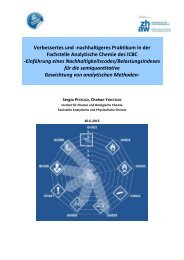You also want an ePaper? Increase the reach of your titles
YUMPU automatically turns print PDFs into web optimized ePapers that Google loves.
According to genetic analyses <strong>of</strong> different c<strong>of</strong>fee species, a relationship among <strong>the</strong> species were proposed and<br />
how c<strong>of</strong>fee evolved in <strong>the</strong> past. This attempt has been made by several research groups, e.g. Maurin et al. 2007<br />
and Anthony et al. 2010. The more similar <strong>the</strong> genome <strong>of</strong> two species is, <strong>the</strong> closer <strong>the</strong>y are related. More<br />
genetic differences between <strong>the</strong>m suggests that <strong>the</strong>y are more distantly related.<br />
Maurin et al. deduced several clades (or groups) <strong>of</strong> closer related species from <strong>the</strong>ir phylogenetic analyses that<br />
also match a certain geographic distribution (see phylogenetic tree, where certain species grow in a restricted<br />
area). The resulting distribution map <strong>of</strong> C<strong>of</strong>fea (on <strong>the</strong> left) shows <strong>the</strong> location <strong>of</strong> those groups: UG = Upper<br />
Guinea clade (West Africa); LG/C = Lower Guinea/ Congolian clade (Lower Guinea and Central Africa); E-CA =<br />
East-Central Africa clade; EA = East Africa clade; Mad = Madagascan clade; MAS = Mascarene clade. The<br />
dahomey gap named on this map is a 250 km wide belt with a much more dry climate that separates <strong>the</strong><br />
woodlands between UG and LG, which is also mirrored in <strong>the</strong> more distant relationship between <strong>the</strong> c<strong>of</strong>fee<br />
species on both sides <strong>of</strong> <strong>the</strong> gap.<br />
Anthony et al proposed that c<strong>of</strong>fee originated in Lower Guinea (Central Africa) in <strong>the</strong> second half <strong>of</strong> Mid<br />
Pleistocene, based on <strong>the</strong>ir findings that <strong>the</strong>re was <strong>the</strong> highest genetic diversity (map on <strong>the</strong> right). From <strong>the</strong>re<br />
<strong>the</strong> whole <strong>of</strong> Equatorial Africa and <strong>the</strong> Madagascar region as well as upper Guinea was colonized, also indicated<br />
by arrows. Actual distribution <strong>of</strong> c<strong>of</strong>fee is marked grey, while forest refugees areas are marked black. After that,<br />
c<strong>of</strong>fee expanded naturally to India, Asia and Australia as now also species <strong>of</strong> <strong>the</strong> former genus Psilanthus are<br />
included in C<strong>of</strong>fea.<br />
27








